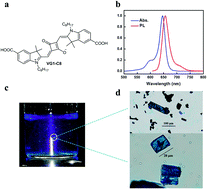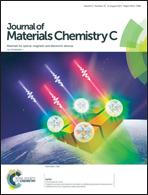Near-infrared emitting single squaraine dye aggregates with large Stokes shifts†
Abstract
The study of supramolecular interactions and aggregation behaviour of functional materials is of great importance to tune and extend their spectral sensitivity and, hence, improve the optoelectronic response of related devices. In this study, we resolve spatially and spectrally the absorption and emission features of squaraine aggregates by means of confocal microscopy and absorption/photoluminescence spectroscopy. We observe that the aggregate affords both a broad absorption spectrum (centred at 1.85 eV and extending to 1.55 eV), likely originated by a dye configuration with allowed J- and H-arrangements, and a strong and relatively narrow emission in the near-infrared (NIR) part of the spectrum (centred at 1.59 eV), with a remarkable Stokes shift of 0.26 eV that is among the largest exhibited by squaraine dyes. These peculiarities would be beneficial for extending the spectral sensitivity of photovoltaic/light-emitting diodes and electrochemical cells, and extremely appealing for possible applications of these aggregates as NIR fluorescent probes in biomedical applications.



 Please wait while we load your content...
Please wait while we load your content...